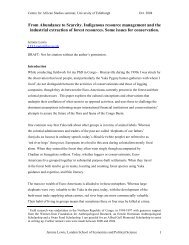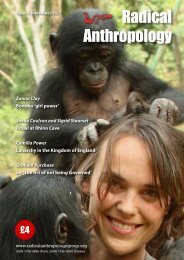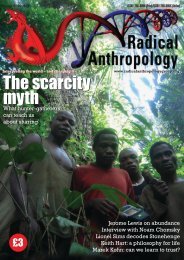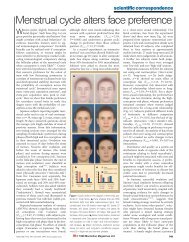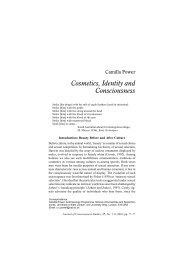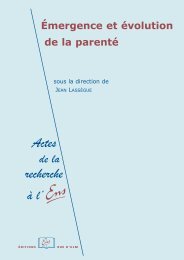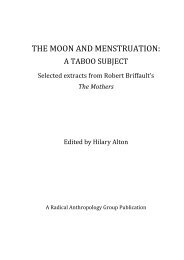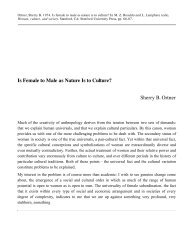Language and life history: A new perspective on the development ...
Language and life history: A new perspective on the development ...
Language and life history: A new perspective on the development ...
- No tags were found...
Create successful ePaper yourself
Turn your PDF publications into a flip-book with our unique Google optimized e-Paper software.
Locke & Bogin: <str<strong>on</strong>g>Language</str<strong>on</strong>g> <str<strong>on</strong>g>and</str<strong>on</strong>g> <str<strong>on</strong>g>life</str<strong>on</strong>g> <str<strong>on</strong>g>history</str<strong>on</strong>g>36 m<strong>on</strong>ths (Locke 1993; 1997). Thus, by <strong>the</strong> time infancydraws to a close, <strong>the</strong> rudiments of a structural linguisticsystem, <str<strong>on</strong>g>and</str<strong>on</strong>g> basic comp<strong>on</strong>ents of a functi<strong>on</strong>al communicativesystem, are operative.2.3. Stage 2: ChildhoodThe childhood stage is peculiar to humans, having beenevoluti<strong>on</strong>arily inserted between <strong>the</strong> infant <str<strong>on</strong>g>and</str<strong>on</strong>g> juvenilestages that characterize social mammals (Bogin 1990).Childhood is defined by several <strong>development</strong>al characteristics,for example, a slowing <str<strong>on</strong>g>and</str<strong>on</strong>g> stabilizati<strong>on</strong> of <strong>the</strong> rate ofgrowth; immature dentiti<strong>on</strong>; feeding characteristics, suchas dependence <strong>on</strong> older people for food; <str<strong>on</strong>g>and</str<strong>on</strong>g> behavioralcharacteristics, including immature motor c<strong>on</strong>trol. Theevoluti<strong>on</strong>ary value of childhood lies in <strong>the</strong> mo<strong>the</strong>r’sfreedom to disc<strong>on</strong>tinue nursing her three-year-old, whichenabled her to initiate a <str<strong>on</strong>g>new</str<strong>on</strong>g> pregnancy. Doing so enhancedreproductive output without increasing <strong>the</strong> risk of mortalityfor <strong>the</strong> mo<strong>the</strong>r, or her infant or older children, for in cooperativelybreeding societies o<strong>the</strong>rs were available to helpcare for <strong>the</strong> young.As shown in Figure 1, <strong>the</strong> end of <strong>the</strong> rapid growth decelerati<strong>on</strong>of infancy marks <strong>the</strong> beginning of childhood, when<strong>the</strong> growth rate levels off at about 5 cm per year. Stabilizati<strong>on</strong>of growth rate is rare in mammals; typically, growthc<strong>on</strong>tinues to decelerate between infancy <str<strong>on</strong>g>and</str<strong>on</strong>g> adulthood(Brody 1945; Tanner 1962). In childhood, brain growthtapers off, at least by weight (Fig. 2), with its masspeaking at about age seven years (Cabana et al. 1993),with a small increase occurring later at puberty (Durst<strong>on</strong>et al. 2001; Sowell et al. 2001). Myelinati<strong>on</strong> <str<strong>on</strong>g>and</str<strong>on</strong>g> somenerve pro<str<strong>on</strong>g>life</str<strong>on</strong>g>rati<strong>on</strong> c<strong>on</strong>tinue into adulthood (Bjorklund &Pellegrinni 2002; Taupin & Gage 2002).In virtually all o<strong>the</strong>r mammalian species, <str<strong>on</strong>g>and</str<strong>on</strong>g> in all n<strong>on</strong>humanprimates, maternal lactati<strong>on</strong> c<strong>on</strong>tinues until <strong>the</strong>erupti<strong>on</strong> of <strong>the</strong> first permanent molar (Smith & Tompkins1995). With adult molars <str<strong>on</strong>g>and</str<strong>on</strong>g> o<strong>the</strong>r teeth in place, <strong>the</strong>o<strong>the</strong>r primates move <strong>on</strong> to <strong>the</strong> juvenile stage <str<strong>on</strong>g>and</str<strong>on</strong>g> mustforage for food <str<strong>on</strong>g>and</str<strong>on</strong>g> o<strong>the</strong>rwise care for <strong>the</strong>mselves withlittle or no assistance. In <strong>the</strong> human infant, of course,o<strong>the</strong>r foods are supplied prior to weaning. But <strong>the</strong> cessati<strong>on</strong>of lactati<strong>on</strong> places a great nutriti<strong>on</strong>al burden <strong>on</strong> <strong>the</strong>weaned infant, with <strong>the</strong> high metabolic dem<str<strong>on</strong>g>and</str<strong>on</strong>g>s of abrain that is still growing rapidly. The typical three-yearoldis too motorically immature to forage or prepare itsown food, <str<strong>on</strong>g>and</str<strong>on</strong>g> too limited by deciduous dentiti<strong>on</strong> <str<strong>on</strong>g>and</str<strong>on</strong>g> asmall gastrointestinal tract to eat <str<strong>on</strong>g>and</str<strong>on</strong>g> digest <strong>the</strong> adult diet.The soluti<strong>on</strong> to this “feeding crisis” is for older membersof <strong>the</strong> social group to provide specially prepared foods thatare high in energy <str<strong>on</strong>g>and</str<strong>on</strong>g> nutrients until self-care becomespossible, <str<strong>on</strong>g>and</str<strong>on</strong>g> in various hunter-ga<strong>the</strong>rer societies this iswhat is d<strong>on</strong>e (Blurt<strong>on</strong> J<strong>on</strong>es 1993; Estioko-Griffin 1986;Hewlett 1991). 3 Summarizing <strong>the</strong> data from manyhuman societies, Lancaster <str<strong>on</strong>g>and</str<strong>on</strong>g> Lancaster (1983) calledthis type of childcare <str<strong>on</strong>g>and</str<strong>on</strong>g> feeding “<strong>the</strong> hominid adaptati<strong>on</strong>,”for no o<strong>the</strong>r primate or mammal is so activelyinvolved in <strong>the</strong>se ways. The l<strong>on</strong>g period of food provisi<strong>on</strong>ing,extending from ages three to seven years, largely defines<strong>the</strong> childhood stage of human <str<strong>on</strong>g>life</str<strong>on</strong>g> <str<strong>on</strong>g>history</str<strong>on</strong>g>. By age seven,usually, <strong>the</strong> four permanent first molars have erupted<str<strong>on</strong>g>and</str<strong>on</strong>g> <strong>the</strong> permanent incisors have begun to replace “milk”incisors. With parallel changes in <strong>the</strong> size <str<strong>on</strong>g>and</str<strong>on</strong>g> strengthof <strong>the</strong> jaws, <str<strong>on</strong>g>and</str<strong>on</strong>g> in <strong>the</strong> muscles of masticati<strong>on</strong>,children – <strong>on</strong> <strong>the</strong> threshold of juvenility – become ableto eat <strong>the</strong> same foods as adults.During this period, mo<strong>the</strong>rs often participate in childhoodfeeding if <strong>the</strong>y are nei<strong>the</strong>r pregnant nor nursing a<str<strong>on</strong>g>new</str<strong>on</strong>g> infant, but <str<strong>on</strong>g>new</str<strong>on</strong>g> reproductive efforts are likely toc<strong>on</strong>sume most of <strong>the</strong>ir free energy <str<strong>on</strong>g>and</str<strong>on</strong>g> time. This is <strong>the</strong>case for all o<strong>the</strong>r mammals, <str<strong>on</strong>g>and</str<strong>on</strong>g> it is <strong>the</strong> reas<strong>on</strong> why <strong>the</strong>birth interval between successful pregnancies is equal to<strong>the</strong> age of first molar erupti<strong>on</strong> in species without <strong>the</strong>human style of social care after weaning. For humans,early weaning (by age three years) relative to molar erupti<strong>on</strong>(age six years) reduces <strong>the</strong> birth interval <str<strong>on</strong>g>and</str<strong>on</strong>g> allows<strong>the</strong> mo<strong>the</strong>r to successfully produce two offspring in <strong>the</strong>time it takes chimpanzees <str<strong>on</strong>g>and</str<strong>on</strong>g> orangutans to successfullyrear <strong>on</strong>e. Thus, we see childhood as an adaptati<strong>on</strong> thatenhances <strong>the</strong> quantity of maternal reproductive outputwithout sacrificing <strong>the</strong> quality of any offspring. Wediscuss <strong>the</strong> o<strong>the</strong>r aspects of <strong>the</strong> evoluti<strong>on</strong>ary basis forchildhood in more detail later.On <strong>the</strong> social fr<strong>on</strong>t, childhood typically produces <str<strong>on</strong>g>new</str<strong>on</strong>g>extrafamilial friendships, frequently co-timed withgrowing disenchantment with siblings (Dunn 1996). Insome modern societies, social hierarchies have alreadydeveloped by <strong>the</strong> age of five. In <strong>the</strong>se hierarchies, lowstatuschildren direct positive behaviors to <strong>the</strong>ir higherstatus peers, evidently without reciprocati<strong>on</strong> (Strayer &Trudel 1984). Children with good communicati<strong>on</strong> skillsare likely to be particularly popular (Asher & Renshaw1981; Gottman et al. 1975; Putallaz & Gottman 1981),whereas children with speech <str<strong>on</strong>g>and</str<strong>on</strong>g> language disorderstend to be unpopular <str<strong>on</strong>g>and</str<strong>on</strong>g> l<strong>on</strong>ely, <str<strong>on</strong>g>and</str<strong>on</strong>g> may even be victimized(Blood & Blood 2004; C<strong>on</strong>ti-Ramsden & Botting2004; Davis et al. 2002). Children with pragmatic orhigher-level language processing disorders are at risk ofserious peer interacti<strong>on</strong> problems (Botting & C<strong>on</strong>ti-Ramsden 2000), <str<strong>on</strong>g>and</str<strong>on</strong>g> similar problems may arise in laterstages of <strong>development</strong> (Place & Becker 1991). Significantly,patterns of friendship <str<strong>on</strong>g>and</str<strong>on</strong>g> rejecti<strong>on</strong> in childhoodset up modes of relating that frequently persist throughsucceeding stages into adulthood (Kohlberg et al. 1972).In what has come to be known as <strong>the</strong> “five to seven yearshift” (Sameroff & Haith 1996), <str<strong>on</strong>g>new</str<strong>on</strong>g> learning <str<strong>on</strong>g>and</str<strong>on</strong>g> behavioralcapabilities emerge, <str<strong>on</strong>g>and</str<strong>on</strong>g> <strong>the</strong>se enable greatersocial independence (Bogin 1999a). Walking becomesadult-like by age seven years (Bogin 1999b). Cognitive<str<strong>on</strong>g>and</str<strong>on</strong>g> emoti<strong>on</strong>al <strong>development</strong>s permit <str<strong>on</strong>g>new</str<strong>on</strong>g> levels of selfsufficiency(Tomasello & Call 1997). Seven-year-olds canperform many basic tasks, including food preparati<strong>on</strong>,infant care, <str<strong>on</strong>g>and</str<strong>on</strong>g> o<strong>the</strong>r domestic tasks, with little or nosupervisi<strong>on</strong> (Rogoff 1996; Weisner 1996). The n<strong>on</strong>linguistictraits associated with human childhood <strong>the</strong>reforeinclude:1. slow <str<strong>on</strong>g>and</str<strong>on</strong>g> steady rate of body growth <str<strong>on</strong>g>and</str<strong>on</strong>g> relativelysmall body size2. large, fast-growing brain3. higher resting metabolic rate than any o<strong>the</strong>r mammalianspecies4. immature dentiti<strong>on</strong>5. dependence <strong>on</strong> older people for care <str<strong>on</strong>g>and</str<strong>on</strong>g> feeding6. motor <str<strong>on</strong>g>and</str<strong>on</strong>g> cognitive advances.No o<strong>the</strong>r mammalian species has this entire suite offeatures, or a <strong>development</strong>al period that is comparableto childhood.262 BEHAVIORAL AND BRAIN SCIENCES (2006) 29:3



